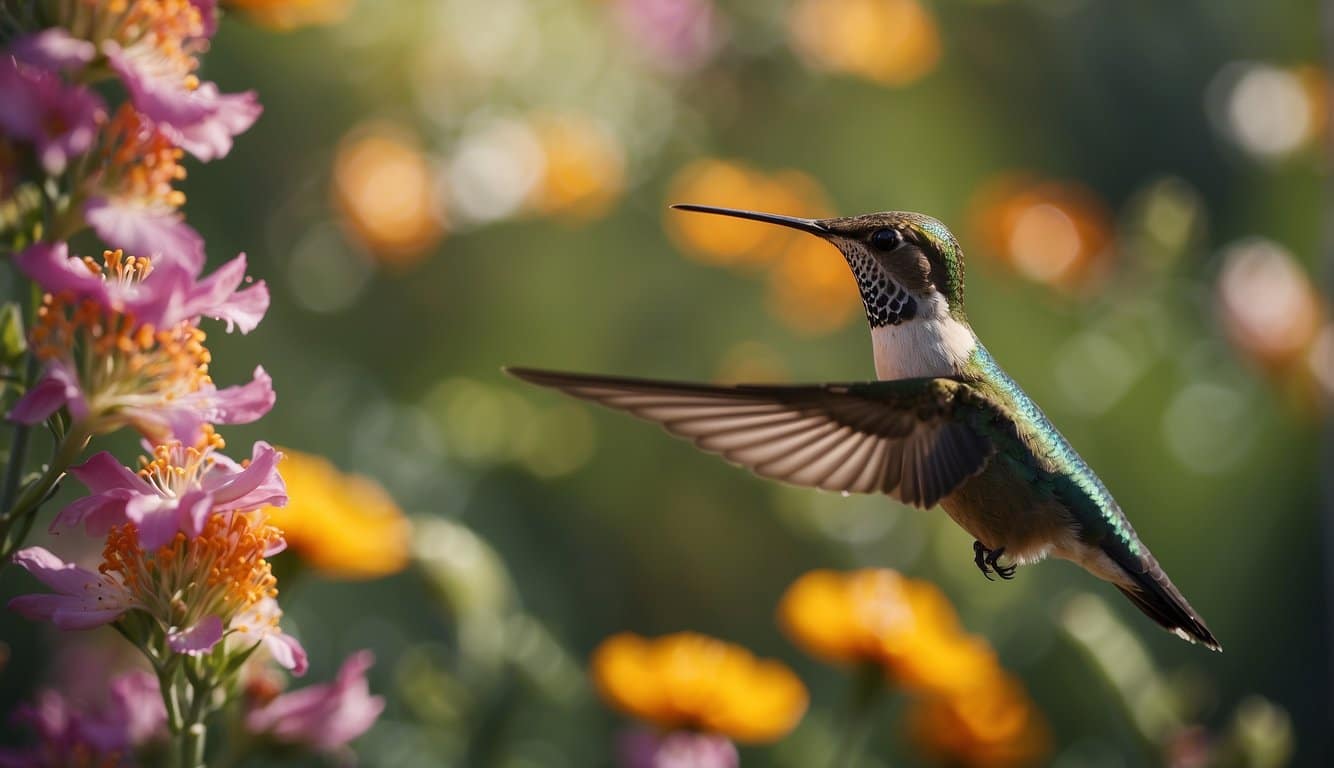| Question | Are Hummingbirds Pollinators? |
|---|---|
| Answer | Yes, Effective Pollinators |
| More Info | Hummingbirds are considered effective pollinators, especially for tubular flowers that are adapted to their feeding habits. As they move from flower to flower to consume nectar, their heads come into contact with the flower’s reproductive organs, transferring pollen. They play a crucial role in the pollination of many native plants, contributing to biodiversity and the health of ecosystems. Their preference for brightly colored flowers, especially red, helps them locate nectar sources easily. |
As you wander through gardens or the wilds, you might observe the unmistakable darting flight of hummingbirds.
These tiny avian wonders are not just a delight to watch, but they also play a critical role in nature’s grand tapestry.
Hummingbirds are indeed pollinators, and their contributions to the health of ecosystems are invaluable.
With their unique flying ability, allowing them to hover in place as they sip nectar, they inadvertently collect pollen on their heads and feathers and transport it from flower to flower, helping plants to reproduce.
Understanding the importance of hummingbirds in pollination helps to appreciate their role beyond their aesthetic appeal.
Their slender beaks and long tongues are perfectly designed for reaching the nectar in deep, tubular flowers, a trait that makes them specially suited for the job.
Plants that rely on hummingbirds for pollination often have flowers that are red or bright-colored and lack a strong scent, as these birds are drawn to vivid visuals rather than olfactory signals.
In their search for nectar, hummingbirds assist in the pollination of around 8,000 species of plants in the Western Hemisphere, highlighting their significant role in biodiversity.
Hummingbird Pollination Biology
Hummingbirds are astonishingly efficient pollinators, adapted through evolution to fill a crucial niche in the pollination of various plants.
Anatomy for Pollination
Your fascination with hummingbirds might peak as you learn that their anatomy is exquisitely suited for pollination.
They boast long, slender beaks that allow access to nectar deep within flowers. But it’s their tube-like, extendable tongues that truly facilitate the transfer of pollen.
These tongues dart in and out at rapid speeds, sipping nectar and inadvertently picking up pollen from flower to flower.
Floral Preferences
One of the most captivating aspects of hummingbird biology is their preference for certain types of flowers.
Typically, hummingbirds are drawn to tubular vibrant flowers that are often red, orange, or pink. These flowers not only provide the high-calorie nectar needed to sustain a hummingbird’s high metabolism but are also anatomically geared for hummingbird pollination, generally being less inviting to insects by lacking landing platforms or strong scents.
This mutualistic relationship ensures that hummingbirds are effective agents in the process of bird pollination.
Hummingbirds are a Great Member of the Ecosystem
Hummingbirds fulfill a vital niche in various ecosystems, primarily through their role in pollination and facilitating plant reproduction.
Pollination Services
When you observe a hummingbird darting from flower to flower, you’re witnessing a key ecological service in action.
Their slender bills and long tongues are perfectly designed for accessing nectar within flowers.
This form of feeding not only benefits the birds, providing them with necessary energy, but also plants, as hummingbirds inadvertently transfer pollen.
The pollen sticks to their beaks and feathers, and as they move to the next flower, they play an essential part in cross-pollination.
Biodiversity and Plant Reproduction
The presence of hummingbirds in an ecosystem often signals a robust array of plant life.
They are agents of biodiversity, as their pollination efforts help propagate numerous plant species.
While sipping nectar, these birds carry pollen which enhances genetic diversity through the fertilization of various flowering plants.
This action promotes healthier and more diverse plant populations, which in turn supports a wider range of wildlife—contributing to the overall resilience of their habitats.
Frequently Asked Questions
In this section, you’ll find concise answers to some common questions regarding the role of hummingbirds in pollination and their impact on ecosystems.
What role do hummingbirds play in pollination?
Hummingbirds are vital pollinators, using their long, slender bills to reach nectar deep inside flowers. In this process, they inadvertently transfer pollen between blooms, facilitating the reproduction of a variety of plant species.
Which plants rely on hummingbirds for pollination?
Many plants in North and South America have evolved to attract hummingbirds, such as red, pink, yellow, and orange flowers with tube-shaped blooms matching the hummingbirds’ beak shape. About 8,000 plant species depend on hummingbirds for their pollination services.
Why are hummingbirds considered important to biodiversity?
Their role as pollinators makes hummingbirds crucial for maintaining the diversity of ecosystems. They help sustain the populations of plants which other species rely on for food and habitat, thus supporting overall biodiversity.
How do hummingbirds contribute to the pollination of fruit trees?
While hummingbirds are typically more associated with pollinating wildflowers, they can also contribute to the pollination of fruit trees whose flowers appeal to their feeding preferences, albeit not as predominantly as bees.
Can hummingbirds assist in pollinating vegetable gardens?
Yes, hummingbirds can assist in the pollination of vegetable gardens, particularly for plants with flowers that attract these birds. However, they are not as commonly relied upon in vegetable pollination as other pollinators like bees.
What impact do environmental changes have on the pollination habits of hummingbirds?
Environmental changes can significantly impact hummingbirds’ pollination habits, potentially disrupting their migratory patterns and available food sources.
This, in turn, affects their effectiveness as pollinators and can lead to a decline in plant species that rely on them.
The U.S. National Park Service discusses these adaptations and their importance.
Last update on 2025-04-18 / Affiliate links / Images from Amazon Product Advertising API




